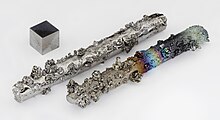Tungsten Pípè / ˈ t ʌ ŋ s t ən / (TUNG -stən Ìhànsójú grayish white, lustrous Ìwúwo átọ̀mù A r, std (W) 183.84(1) [1] Tungsten ní orí tábìlì àyè
Nọ́mbà átọ̀mù (Z ) 74 Ẹgbẹ́ group 6 Àyè àyè 6 Àdìpọ̀ Àdìpọ̀-d Ẹ̀ka ẹ́límẹ́ntì Transition metal Ìtò ẹ̀lẹ́ktrọ́nù [Xe ] 4f14 5d4 6s2 [2] Iye ẹ̀lẹ́ktrọ́nù lórí ìpele kọ̀ọ̀kan 2, 8, 18, 32, 12, 2 Àwọn ohun ìní ara Ìfarahàn at STP solid Ìgbà ìyọ́ 3695 K (3422 °C, 6192 °F) Ígbà ìhó 5828 K (5555 °C, 10031 °F) Kíki (near r.t. ) 19.25 g/cm3 when liquid (at m.p. ) 17.6 g/cm3 Critical point 13892 K, MPa Heat of fusion 52.31 kJ/mol Heat of 806.7 kJ/mol Molar heat capacity 24.27 J/(mol·K) pressure
P (Pa)
1
10
100
1 k
10 k
100 k
at T (K)
3477
3773
4137
4579
5127
5823
Atomic properties Oxidation states −4, −2, −1, 0, +1, +2, +3, +4 +6 Àdàkọ:Infobox element/symbol-to-oxidation-state/comment Electronegativity Pauling scale: 2.36 Atomic radius empirical: 139 pm Covalent radius 162±7 pm Color lines in a spectral range Spectral lines of tungstenOther properties Natural occurrence primordial Crystal structure (bcc) Thermal expansion 4.5 µm/(m·K) (at 25 °C) Thermal conductivity 173 W/(m·K) Electrical resistivity 52.8 n Ω·m (at 20 °C) Magnetic ordering paramagnetic [3] Young's modulus 411 GPa Shear modulus 161 GPa Bulk modulus 310 GPa Poisson ratio 0.28 Mohs hardness 7.5 Vickers hardness 3430 MPa Brinell hardness 2570 MPa CAS Number 7440-33-7 Main isotopes of tungsten
Àdàkọ:Category-inline references 


